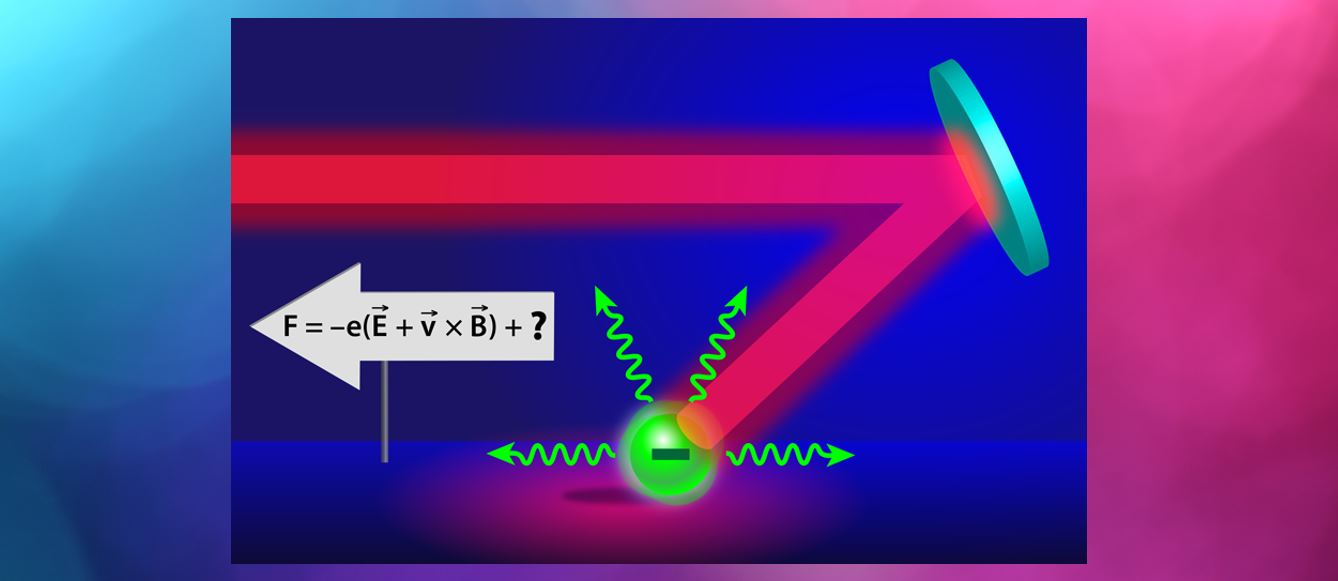INTENSE LASER EXPERIMENTS PROVIDE FIRST EVIDENCE THAT LIGHT CAN STOP ELECTRONS 
08 February 2018
A team of researchers led by Imperial College London and which included Queen’s University, has observed that by hitting electrons with an ultra-intense laser, dynamics go beyond ‘classical’ physics and hint at quantum effects.
It is well known that when shining light on an object, some of the light is reflected and some is transmitted. However, Dr Gianluca Sarri from the School of Mathematics and Physics at Queen’s has been part of an expert team that found that if the object is moving extremely fast, and if the light is incredibly intense, strange things can happen.
Electrons, for example, can be shaken so violently that they actually slow down because of the energy they radiate. Physicists call this process ‘radiation reaction’.
This radiation reaction is thought to occur around objects such as black holes and quasars (supermassive black holes surrounded by a disc of gas). Being able to measure radiation reaction in the lab will therefore provide insights into processes that occur in some of the most extreme environments in the universe.
Radiation reaction is also interesting to physicists studying effects beyond ‘classical’ physics, as the equations (known as Maxwell’s equations) that traditionally define how light behaves can fall short in these extreme environments.
Now, the team of researchers, which included Queen’s University and was led by Imperial College London, has directly observed radiation reaction in the lab for the first time. ‘Experimental evidence of radiation reaction in the collision of a high-intensity laser pulse with a laser-wakefield accelerated electron beam’ is published in the journal Physical Review X.
They were able to observe this radiation reaction by colliding a laser beam one quadrillion (a billion million) times brighter than light at the surface of the Sun with a high-energy beam of electrons. The experiment, which required extreme precision and exquisite timing, was achieved using the Gemini laser at the Science and Technology Facilities Council’s Central Laser Facility in the UK.
Photons of light that reflect from an object moving close to the speed of light have their energy increased. In the extreme conditions of this experiment, this shifts the reflected light from the visible part of the spectrum all the way up to high energy gamma rays. This effect let the researchers know when they had successfully collided the beams.
Dr Sarri commented: “The results are exciting as, they open up an entirely new area of research. Not only are the implications for fundamental physics and astrophysics invaluable, but these results effectively pave the way for ultra-high intensity studies that will be carried out with international facilities, such as the Extreme Light Infrastructure.”
Senior author of the study, Dr Stuart Mangles from the Department of Physics at Imperial College London, said: “We knew we had been successful in colliding the two beams when we detected very bright high energy gamma-ray radiation.
“The real result then came when we compared this detection with the energy in the electron beam after the collision. We found that these successful collisions had a lower than expected electron energy, which is clear evidence of radiation reaction.”
Study co-author Professor Alec Thomas, from Lancaster University and the University of Michigan, added: "One thing I always find so fascinating about this is that the electrons are stopped as effectively by this sheet of light, a fraction of a hair's breadth thick, as by something like a millimetre of lead. That is extraordinary."
The data from the experiment also agrees better with a theoretical model based on the principles of quantum electrodynamics, rather than Maxwell’s equations, potentially providing some of the first evidence of previously untested quantum models.
However, more experiments at even higher intensity or with even higher energy electron beams will be needed to confirm the preliminary results. The team will be carrying out these experiments in the coming year.
The team was able to make the light so intense in the current experiment by focussing it to a very small spot (just a few micrometres – millionths of a metre – across) and delivering all the energy in a very short duration (just 40 femtoseconds long: 40 quadrillionths of a second).
To make the electron beam small enough to interact with the focussed laser, the team used a technique called ‘laser wakefield acceleration’. The technique fires another intense laser pulse into a gas, turning it into a plasma and driving a wave, called the wakefield, behind it as it travels through the plasma. Electrons in the plasma can surf on this wake and reach very high energies in a very short distance.
Media inquiries to Emma Gallagher at Queen’s University Communications Office T; +44 (0)28 9097 5384 E: emma.gallagher@qub.ac.uk
Photo credits: Imperial College London
Back to Main News
Top of Page